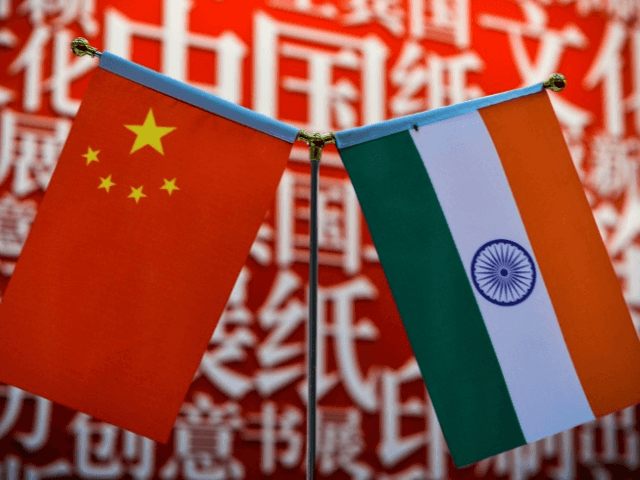Indian Minister of External Affairs Subrahmanyam Jaishanka and Chinese Foreign Minister Wang Yi issued a statement late Thursday agreeing to “disengage” on the nations’ mutual border after a tense summer marked by deadly military scuffles in the Himalayas.
The two nations last issued a similar statement a week before the deadliest clash between the two on their border in over half a century. China claims a significant percentage of Indian territory on its southwestern border, which it refers to as “South Tibet,” while India has been pushing troops into disputed terrain in the months following that clash, allegedly to prevent a similar incident.
The latest military exchange between the two occurred this week following an Indian military statement a week ago declaring that the Indian Army had prevented China’s People’s Liberation Army (PLA) from establishing a surveillance position in the Ladakh region, which borders occupied Tibet. That incident resulted in an Indian Army contingent establishing a new base on a mountaintop overlooking Pangong Tso, a lake that straddles the border, which Chinese soldiers attempted and failed to dislodge this week.
Indian media published alarming photos and video this week of Chinese soldiers carrying rudimentary weapons such as spears and machetes, and undated evidence of a brawl between soldiers of both sides.
Despite the heightened tensions — reports indicate soldiers are as little as 200 feet away from opposing troops on some parts of the border — Wang and Jaishanka said in their joint statement that their “frank and constructive discussion” would result in de-escalation. The statement followed what the Hindustan Times reported was a two-and-a-half-hour meeting between the two in Moscow, where both attended the Shanghai Cooperation Organization meeting. The ministers agreed to five points, most of which do not constitute concrete actions.
“The two Ministers agreed that both sides should take guidance from the series of consensus of the leaders on developing India-China relations, including not allowing differences to become disputes,” one of the points read. Another merely stated that the two would “continue their dialogue” and “quickly disengage.” The third was a vow to “abide by all the existing agreements;” the fourth mandated dialogue (again); and the fifth was a vow to continue work on unspecified “Confidence Building Measures.'”
The Chinese Foreign Ministry claimed that Wang had made five other proposals at the Moscow meeting to members of the Shanghai Cooperation Organization generally.
“State Councilor and Foreign Minister Wang Yi put forward five proposals for strengthening SCO cooperation. First, to firmly support each other and uphold each other’s core interests. Second, to stand in solidarity and cooperate with each other in this fight against COVID-19 [Chinese coronavirus],” Foreign Ministry spokesman Zhao Lijian told reporters on Friday. “Third, to persist in sharing weal and woe to resolve various security risks. Fourth, to adhere to coordinated development and boost economic recoveries in the member states. Fifth, to uphold multilateralism and improve global governance.”
Zhao added that Wang used the occasion to call for no member state at the Shanghai Cooperation Organization meeting to “allow external forces to intervene in their internal affairs, a ‘color revolution’ to succeed in this region, or the regional peace and stability to be undermined.” “Color Revolution” is an increasingly outdated term used to refer to the anti-leftist political movements in eastern Europe during the 2000s.
China and India similarly agreed to deescalate tensions in the Himalayas in early June.
“Both sides agreed to peacefully resolve the situation in the border areas in accordance with various bilateral agreements and keeping in view the agreement between the leaders that peace and tranquility in the India-China border regions is essential for the overall development of bilateral relations,” the Indian Ministry of External Affairs declared then.
A week later, about 20 Indian soldiers and an unknown number of Chinese troops, which India claimed was twice its casualty count, died in hand-to-hand combat in the Galwan Valley, part of India’s Ladakh region.
The incident began, Indian officials detailed, when a ranking Indian officer found PLA troops had pitched tents and established themselves on sovereign Indian land. When the officer approached the Chinese soldiers, they attacked using rocks, sticks wrapped in barbed wire, and other weapons. India and China have for decades established rules of engagement that prohibit the use of firearms on the border, which India revoked following this incident.
The military clash last week, which resulted in Indian troops taking over a previously unclaimed Pangong Tso mountaintop, occurred to prevent another Galwan Valley massacre, the Indian government claimed, as Indian troops saw PLA forces approaching with tents and surveillance equipment that could be used to establish a similar presence as the one in the Galwan Valley. Chinese diplomats vocally protested Indian troops’ presence anywhere near Pangong Tso, claiming it as sovereign Chinese territory.
On Monday, troops fired the first bullets across the border in 45 years. The Chinese government claimed Indian troops did the shooting, while the Indian military admitted to some “warning” shots but said they followed initial fire from the Chinese. Indian media published photos after the exchange of Chinese soldiers carrying rifles, as well as machetes and spears.

COMMENTS
Please let us know if you're having issues with commenting.